cooling Lancia Thesis 2006 Owner handbook (in English)
[x] Cancel search | Manufacturer: LANCIA, Model Year: 2006, Model line: Thesis, Model: Lancia Thesis 2006Pages: 386, PDF Size: 8.69 MB
Page 256 of 386
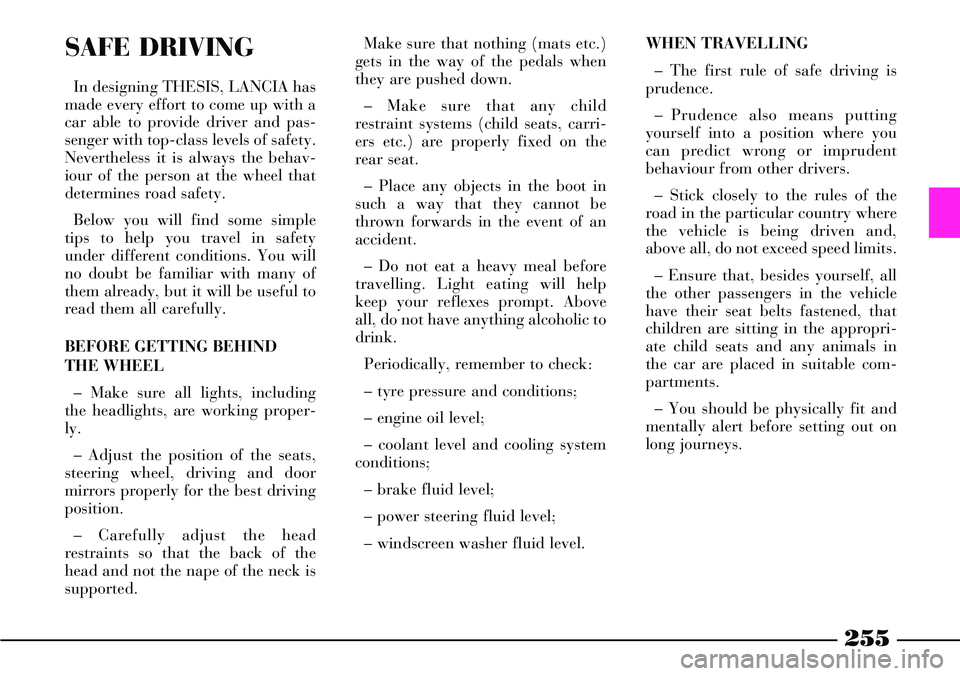
255
SAFE DRIVING
In designing THESIS, LANCIA has
made every effort to come up with a
car able to provide driver and pas-
senger with top-class levels of safety.
Nevertheless it is always the behav-
iour of the person at the wheel that
determines road safety.
Below you will find some simple
tips to help you travel in safety
under different conditions. You will
no doubt be familiar with many of
them already, but it will be useful to
read them all carefully.
BEFORE GETTING BEHIND
THE WHEEL
– Make sure all lights, including
the headlights, are working proper-
ly.
– Adjust the position of the seats,
steering wheel, driving and door
mirrors properly for the best driving
position.
– Carefully adjust the head
restraints so that the back of the
head and not the nape of the neck is
supported. Make sure that nothing (mats etc.)
gets in the way of the pedals when
they are pushed down.
– Make sure that any child
restraint systems (child seats, carri-
ers etc.) are properly fixed on the
rear seat.
– Place any objects in the boot in
such a way that they cannot be
thrown forwards in the event of an
accident.
– Do not eat a heavy meal before
travelling. Light eating will help
keep your reflexes prompt. Above
all, do not have anything alcoholic to
drink.
Periodically, remember to check:
– tyre pressure and conditions;
– engine oil level;
– coolant level and cooling system
conditions;
– brake fluid level;
– power steering fluid level;
– windscreen washer fluid level. WHEN TRAVELLING
– The first rule of safe driving is
prudence.
– Prudence also means putting
yourself into a position where you
can predict wrong or imprudent
behaviour from other drivers.
– Stick closely to the rules of the
road in the particular country where
the vehicle is being driven and,
above all, do not exceed speed limits.
– Ensure that, besides yourself, all
the other passengers in the vehicle
have their seat belts fastened, that
children are sitting in the appropri-
ate child seats and any animals in
the car are placed in suitable com-
partments.
– You should be physically fit and
mentally alert before setting out on
long journeys.
Page 270 of 386
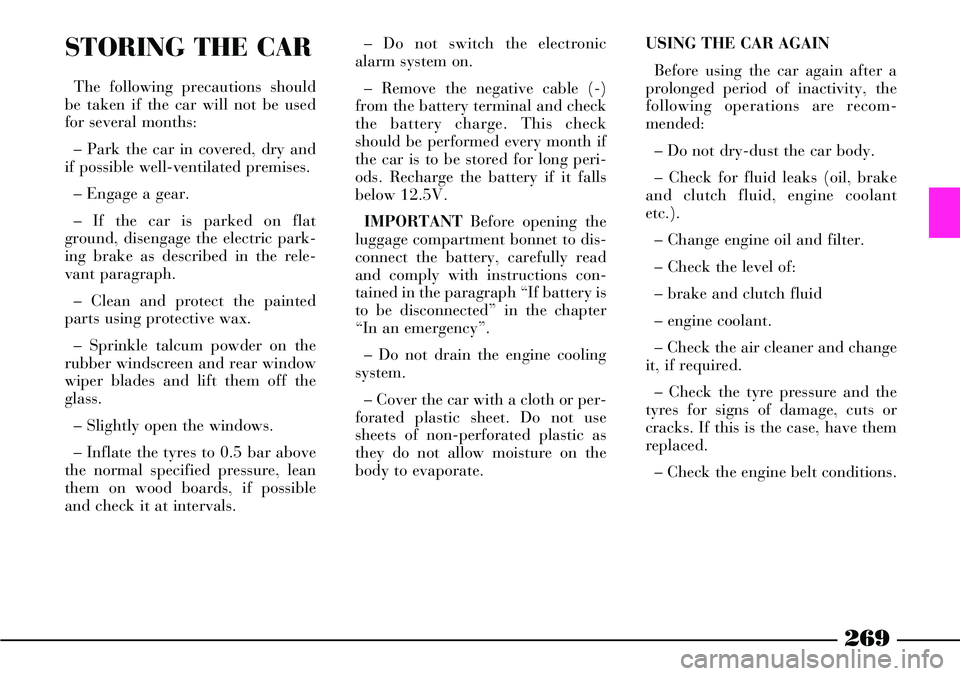
269
USING THE CAR AGAIN
Before using the car again after a
prolonged period of inactivity, the
following operations are recom-
mended:
– Do not dry-dust the car body.
– Check for fluid leaks (oil, brake
and clutch fluid, engine coolant
etc.).
– Change engine oil and filter.
– Check the level of:
– brake and clutch fluid
– engine coolant.
– Check the air cleaner and change
it, if required.
– Check the tyre pressure and the
tyres for signs of damage, cuts or
cracks. If this is the case, have them
replaced.
– Check the engine belt conditions.STORING THE CAR
The following precautions should
be taken if the car will not be used
for several months:
– Park the car in covered, dry and
if possible well-ventilated premises.
– Engage a gear.
– If the car is parked on flat
ground, disengage the electric park-
ing brake as described in the rele-
vant paragraph.
– Clean and protect the painted
parts using protective wax.
– Sprinkle talcum powder on the
rubber windscreen and rear window
wiper blades and lift them off the
glass.
– Slightly open the windows.
– Inflate the tyres to 0.5 bar above
the normal specified pressure, lean
them on wood boards, if possible
and check it at intervals.– Do not switch the electronic
alarm system on.
– Remove the negative cable (-)
from the battery terminal and check
the battery charge. This check
should be performed every month if
the car is to be stored for long peri-
ods. Recharge the battery if it falls
below 12.5V.
IMPORTANT Before opening the
luggage compartment bonnet to dis-
connect the battery, carefully read
and comply with instructions con-
tained in the paragraph “If battery is
to be disconnected” in the chapter
“In an emergency”.
– Do not drain the engine cooling
system.
– Cover the car with a cloth or per-
forated plastic sheet. Do not use
sheets of non-perforated plastic as
they do not allow moisture on the
body to evaporate.
Page 285 of 386

284
IF AN EXTERIOR
BULB BURNS OUT
FRONT LIGHT CLUSTER
The front light cluster includes
main beam headlights/dipped beam
headlights, additional main beam
headlights, direction indicators and
sidelights.Light layout is the following
(fig. 23):
A– Main beam headlight/dipped
beam headlight (bi-Xeno bulb)
B– Sidelight
C– Additional main beam head-
light
D– Direction indicator.Any operation on the
front light cluster must be
made with the stalk at 0
(lights off) and ignition key
removed for at least 15 minutes
(to let bulb cooling and con-
densers discharging): risk of elec-
trical discharge!
fig. 23
L0A0106b
To replace front head-
light bulbs, front light
clusters shall be removed.
It is therefore recommended to
the bulbs replaced at Lancia
Dealership.Due to high voltage, the
bulb of bi-Xeno gas-dis-
charge headlights must
only be replaced by experts: dan-
ger of death! Contact the Lancia
Dealership.
Page 299 of 386

298
Devices and utilities
Horn
Windscreen wiper controls
Brake light control (NC)
Brake light control (NA)
Ignition switch
Air conditioner compressor
Cruise Control (satellite controls)
Cruise Control (Adaptive point)
Climate control system fan
Engine cooling electric fan (first)
Engine cooling electric fan (second)
Right-hand headlight (control unit)
Left-hand headlight (control unit)
Diesel fuel filter (PTC)
Electronic injection system
Injectors (diesel versions)
Driving position point interface
Automatic transmission point interface
Climate control system point interface
Fuse
11
23
20
14
7
12
20
20
5
3
4
10
10
16
13
19
14
15
23
6
15
Ampere
15
7.5
7.5
10
20
7.5
7.5
7.5
40
60
20
7.5
7.5
20
7.5
20
20
10
7.5
10
7.5
Location
fig. 75
fig. 73
fig. 73
fig. 73
fig. 75
fig. 75
fig. 73
fig. 73
fig. 75
fig. 75
fig. 78
fig. 78
fig. 78
fig. 75
fig. 75
fig. 75
fig. 78
fig. 78
fig. 73
fig. 73
fig. 73
Page 314 of 386
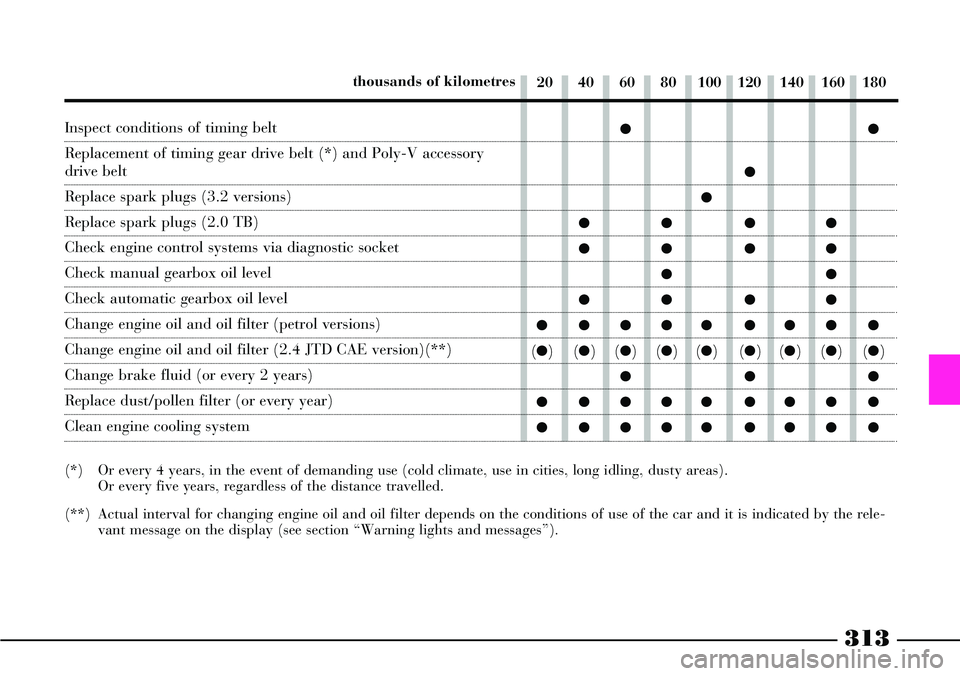
313
Inspect conditions of timing belt
Replacement of timing gear drive belt (*) and Poly-V accessory
drive belt
Replace spark plugs (3.2 versions)
Replace spark plugs (2.0 TB)
Check engine control systems via diagnostic socket
Check manual gearbox oil level
Check automatic gearbox oil level
Change engine oil and oil filter (petrol versions)
Change engine oil and oil filter (2.4 JTD CAE version)(**)
Change brake fluid (or every 2 years)
Replace dust/pollen filter (or every year)
Clean engine cooling system
(*) Or every 4 years, in the event of demanding use (cold climate, use in cities, long idling, dusty areas).
Or every five years, regardless of the distance travelled.
(**) Actual interval for changing engine oil and oil filter depends on the conditions of use of the car and it is indicated by the rele-
vant message on the display (see section “Warning lights and messages”).20 40 60 80 100 120 140 160 180 thousands of kilometres
çç
ç
ç
çç çç
çç çç
çç
çç çç
ççççç çççç
(ç)(ç)(ç)(ç)(ç)(ç)(ç)(ç)(ç)
ççç
ççççç çççç
ççççç çççç
Page 323 of 386
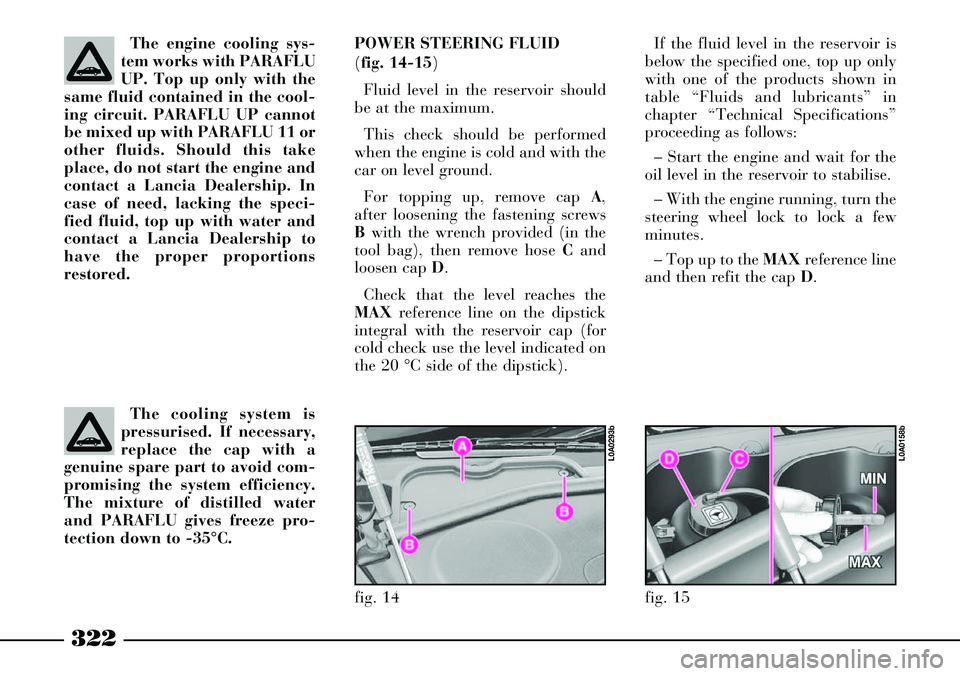
322
fig. 14
L0A0293b
fig. 15
L0A0158b
The engine cooling sys-
tem works with PARAFLU
UP. Top up only with the
same fluid contained in the cool-
ing circuit. PARAFLU UP cannot
be mixed up with PARAFLU 11 or
other fluids. Should this take
place, do not start the engine and
contact a Lancia Dealership. In
case of need, lacking the speci-
fied fluid, top up with water and
contact a Lancia Dealership to
have the proper proportions
restored.
The cooling system is
pressurised. If necessary,
replace the cap with a
genuine spare part to avoid com-
promising the system efficiency.
The mixture of distilled water
and PARAFLU gives freeze pro-
tection down to -35°C. POWER STEERING FLUID
(fig. 14-15)
Fluid level in the reservoir should
be at the maximum.
This check should be performed
when the engine is cold and with the
car on level ground.
For topping up, remove cap A,
after loosening the fastening screws
Bwith the wrench provided (in the
tool bag), then remove hose Cand
loosen cap D.
Check that the level reaches the
MAXreference line on the dipstick
integral with the reservoir cap (for
cold check use the level indicated on
the 20 °C side of the dipstick).If the fluid level in the reservoir is
below the specified one, top up only
with one of the products shown in
table “Fluids and lubricants” in
chapter “Technical Specifications”
proceeding as follows:
– Start the engine and wait for the
oil level in the reservoir to stabilise.
– With the engine running, turn the
steering wheel lock to lock a few
minutes.
– Top up to the MAXreference line
and then refit the cap D.
Page 363 of 386
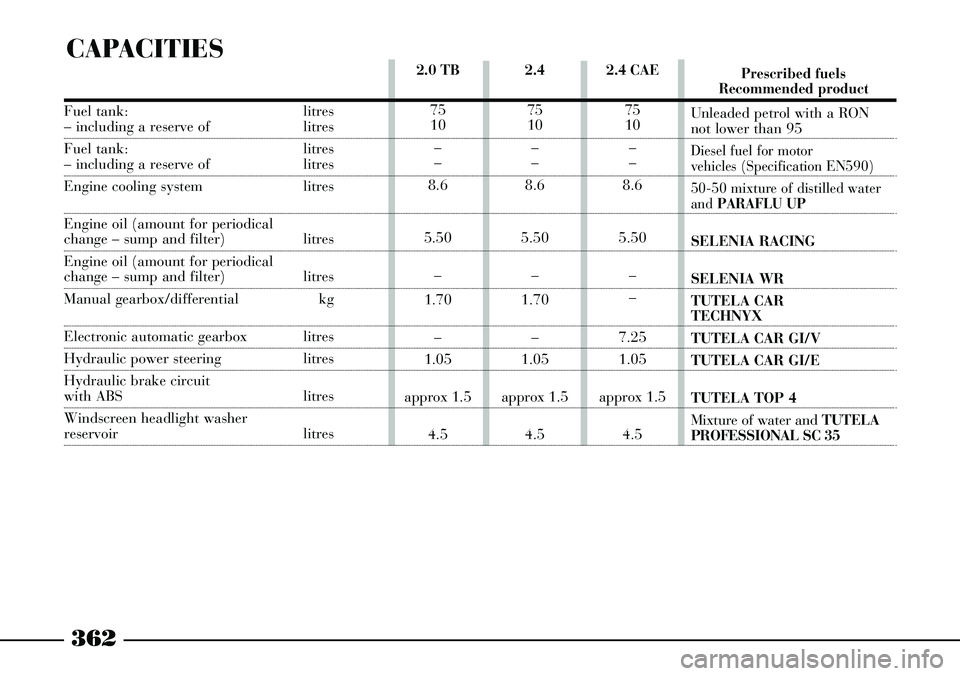
CAPACITIES
Prescribed fuels
Recommended product
Unleaded petrol with a RON
not lower than 95
Diesel fuel for motor
vehicles (Specification EN590)
50-50 mixture of distilled water
and PARAFLU UP
SELENIA RACING
SELENIA WR
TUTELA CAR
TECHNYX
TUTELA CAR GI/V
TUTELA CAR GI/E
TUTELA TOP 4
Mixture of water and TUTELA
PROFESSIONAL SC 35
362
2.4
75
10
–
–
8.6
5.50
–
1.70
–
1.05
approx 1.5
4.5 2.0 TB
75
10
–
–
8.6
5.50
–
1.70
–
1.05
approx 1.5
4.52.4 CAE
75
10
–
–
8.6
5.50
–
–
7.25
1.05
approx 1.5
4.5
Fuel tank: litres– including a reserve of litres
Fuel tank: litres
– including a reserve of litres
Engine cooling system litres
Engine oil (amount for periodical change – sump and filter) litres
Engine oil (amount for periodical
change – sump and filter) litres
Manual gearbox/differential kg
Electronic automatic gearbox litres
Hydraulic power steering litres
Hydraulic brake circuit
with ABS litres
Windscreen headlight washer
reservoir litres
Page 364 of 386

3.2 V6
CAE
75
10
–
–
12.2
5.90
–
–
1.05
approx 1.5
4.5
363
Prescribed fuels
Recommended product
Unleaded petrol with a RON
not lower than 95
Diesel fuel for motor vehicles
(Specification EN590)
50-50 mixture of
distilled water and PARAFLU UP
SELENIA RACING
SELENIA WR
TUTELA CAR GI/V
TUTELA CAR GI/E
TUTELA TOP 4
Mixture of water and TUTELA
PROFESSIONAL SC 35 2.4 JTD
20VCAE
–
–
75
10
8.6
–
5.0
–
1.05
approx 1.5
4.5
Fuel tank: litres
– including a reserve of litres
Fuel tank: litres
– including a reserve of litres
Engine cooling system litres
Engine oil (amount for periodical
change – sump and filter) litres
Engine oil (amount for periodical
change – sump and filter) litres
Electronic automatic gearbox litres
Hydraulic power steering litres
Hydraulic brake circuit
with ABS litres
Windscreen headlight washer
reservoir litres
Page 366 of 386

365
Use
(*) IMPORTANT Do not top up or mix with fluids having characteristics different from those specified.Applications
Mechanical gearbox and
differential petrol version
Mechanical gearbox and
differentials, diesel versions
Power steering
5-speed automatic
transmission
CV joints on wheel side
CV joints on differential side
Brake and clutch hydraulic
control
Cooling circuits
Proportion:
50% water and
50% Paraflu UP
To be used diluted
or undiluted Original fluids
and lubricants
TUTELA CAR
TECHNYX
TUTELA CAR
MATRYX
TUTELA GI/E
TUTELA GI/V
TUTELA STAR 500
TUTELA
MRM ZERO
TUTELA TOP 4
PARAFLU UP (*)
TUTELA
PROFESSIONAL
SC 35 Fluid and lubricant specifications
for correct car operation
Synthetic-based oil, grade SAE 75W-85 that passes
API GL 4 specifications Plus, Fiat 9.55550.
Synthetic-based oil, grade SAE 75W-85, that pass
API GL4 specifications.
"ATF DEXRON III" oil..
Special lubricant for 5-speed transmissions with
controlled slip torque converters
Lithium-soap-based grease with molybdenum
bisulphate. Consistency NLGI 2
Lithium soap based grease. NLGI 0 consistency
Synthetic fluid FMVSS no. 116, DOT 4, ISO 4925,
SAE J-1704 CUNA NC 956-01
Protective with antifreeze action, red colour based on
inhibited monoethylen glycol and organic formula, that
passes CUNA NC 956-16, ASTM D 3306 specifications
Mixture of alcohol, water and surfactants
CUNA NC 956-11 Brake fluid Transmission
and hydraulic
power steering
lubricants and
greases
Protective agent
for radiators
Windscreen/
headlight washer
fluid